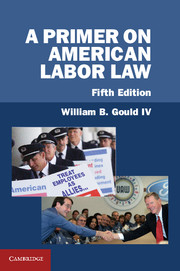Book contents
- Frontmatter
- Contents
- Preface to the Fifth Edition
- Preface to the Fourth Edition
- Preface to the Third Edition
- Preface to the Second Edition
- Preface to the First Edition
- 1 An Overview
- 2 Industrial Relations and Labor Law before Modern Legislation
- 3 The National Labor Relations Act and Related Labor Law
- 4 Unfair Labor Practices
- 5 Establishing the Collective Bargaining Relationship: Organization and Recognition
- 6 Economic Pressure and Bargaining Tactics in the Established Relationship
- 7 Remedies, the Labor Reform Bill of 1978, and the Employee Free Choice Bill of 2009
- 8 Dispute Resolution in the Established Relationship
- 9 The Duty of Fair Representation
- 10 The Public Sector
- 11 Public-Interest Labor Law
- 12 Conclusion
- Index
- References
5 - Establishing the Collective Bargaining Relationship: Organization and Recognition
Published online by Cambridge University Press: 05 June 2013
- Frontmatter
- Contents
- Preface to the Fifth Edition
- Preface to the Fourth Edition
- Preface to the Third Edition
- Preface to the Second Edition
- Preface to the First Edition
- 1 An Overview
- 2 Industrial Relations and Labor Law before Modern Legislation
- 3 The National Labor Relations Act and Related Labor Law
- 4 Unfair Labor Practices
- 5 Establishing the Collective Bargaining Relationship: Organization and Recognition
- 6 Economic Pressure and Bargaining Tactics in the Established Relationship
- 7 Remedies, the Labor Reform Bill of 1978, and the Employee Free Choice Bill of 2009
- 8 Dispute Resolution in the Established Relationship
- 9 The Duty of Fair Representation
- 10 The Public Sector
- 11 Public-Interest Labor Law
- 12 Conclusion
- Index
- References
Summary
This chapter addresses the problems that arise when a union attempts to establish itself as the exclusive bargaining agent for an appropriate unit of workers. It deals with the tactics labor uses and the restraints the law places upon it. (Of course no precise line can be drawn between the legal tactics that are available to labor and management in the organizational context and those that may be used once the collective bargaining relationship has been established. Accordingly the reader should keep the basic concepts and principles discussed here in mind when reading the succeeding chapters.)
Recruitment and Organization
In an organizational campaign, unions and employers are concerned with union attempts to surmount obstacles to communication with workers, union efforts to protect union adherents in the workplace, the tactics that may be employed, and the circumstances under which recognition can be compelled. Unions recruiting workers will generally make contact with a small group of potential union adherents. At the early stages of a union effort this contact may be made secretly, to make it less likely that the employer will counterattack with antiunion communications or unlawful reprisals.
- Type
- Chapter
- Information
- A Primer on American Labor Law , pp. 107 - 162Publisher: Cambridge University PressPrint publication year: 2013



